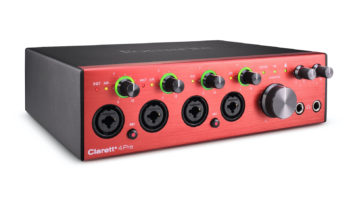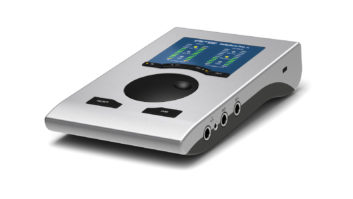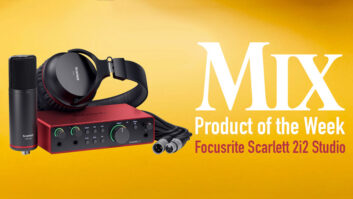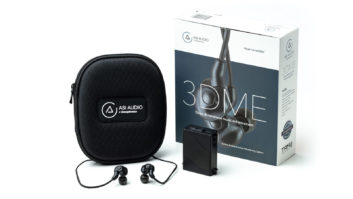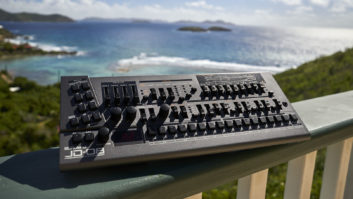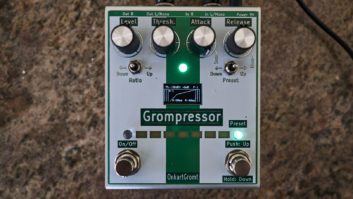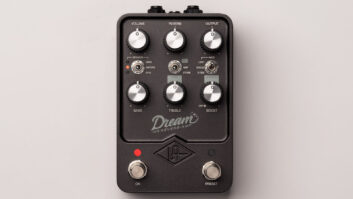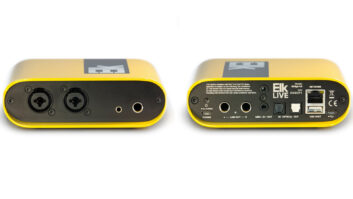People often ask me what audio interface I recommend. I always answer with two questions: “What are you recording?” and “What’s your budget?” There are products on the market that will suit any answers—there is literally something for everyone. Focusrite has taken that idea and run with it in its new lineup of Scarlett interfaces. While this review focuses on the Scarlett 18i20 3rd generation interface, many of the advancements I mention carry across the entire Scarlett line.
Let’s start with what you get: For $499.99, you get a rack-mountable (1RU) interface that can serve as the brains of a respectable production studio. In addition to the 18 inputs (which we’ll get to later), you get enough outputs (20) to drive two sets of stereo speakers and a 5.1 surround array—with a stereo output left over for a cue system. The front panel offers dual headphone outputs with individual control, a speaker switcher, a dimmer and—impressively—a talkback button!
Frank Verderosa Real-World Reviews:
• Real-World Review: Røde RødeCaster Pro Podcast Studio
• Real-World Review: Røde PodMic Podcasting Microphone
While Focusrite has managed to neatly pack the front panel full of knobs and buttons, nothing looks or feels compromised. The knobs are solid and secure, turning smoothly. The buttons engage well and are laid out in a sleek, ergonomic design. You can mount the 18i20 in a rack or choose to not connect the supplied rack ears and use the 18i20 as a desktop interface. Weighing a solid 7 pounds, you don’t have to worry about it sliding away from you as you push buttons.
One issue I had, which might very well be a fault in the unit I was sent, is that the USB-C cable seems to not sit securely enough in the back. On several occasions when I had to move it, the poorly seated cable prompted my computer to tell me the interface was no longer connected. A loose cable is not the end of the world, especially once the unit is in place, but it’s certainly something to be mindful of.
New to the Scarlett line is Air, which is an emulation of the sound of Focusrite’s transformer-based mic preamps; it adds a clean brightness to whichever channel you assign it (via Focusrite’s control software). An “Air” LED will light under the knob on the interface to let you know it’s engaged. It’s a nice touch, but I wonder whether you can’t achieve the same effect with post EQ. Air is smooth and adds a nice crispness to vocals, voiceovers and instruments alike, so while I believe in “leaving it flat” (particularly for voiceover recording), I can see why people appreciate it. Adding Air to Scarlett is a nice bonus, and it brings the unit’s capabilities a little closer to the Clarett line.
The speaker switcher works with the first two pairs of outputs (1&2/3&4), which you’ll need to keep in mind when mapping your I/O for surround or other applications. It would be nice if the dim was adjustable, but I wasn’t able to find a way to change it.
Not being one to pore over manuals, when I unboxed the 18i20 3rd Gen, I went right to Pro Tools I/O and got to work. Setting up I/O was as simple as you’d expect; straight away, I did some experimenting with latency to see how low I could go before Pro Tools glitched. I recorded a bunch of VO, and while I got it to a pretty low latency (setting the buffer to a mere 32!), I couldn’t quite shake that “phasing” sound in my headphones. This might have been less noticeable for an instrument, but for most applications, you’ll probably want to switch to zero latency mode. This is assignable in the mix control software.
The front panel provides easy-to-read LED metering. It’s a nice touch for checking signal and setting levels quickly. There are two phantom power buttons, for inputs 1-4 and/or 5-8, and I’m of two minds about this setup. For one, it makes it easy to get phantom power going when you need it, but at the same time, my instincts tell me it would be better if we could turn phantom on per individual channel. Most modern mics won’t be adversely affected by sending phantom to them when they don’t require it, but still, this setup makes me twitch a little. It’s nice that each input can be assigned a pad via a button right under its knob. Inputs 1 and 2 have an added button for instrument level. Each input has an LED indicator for PAD, AIR, plus INST for 1 and 2.
Speaking of inputs, you get a total of eight pre’s, consisting of two combi jacks on the front that double as dual instrument level in, plus six additional combi jacks on the back. If you’re planning on rack mounting, it’s super handy to have those two front-facing inputs available for quick access to a guitar, bass, synth or whatever you might need. On the rear, you get eight additional optical inputs (via ADAT I/O), stereo SPDIF I/O, MIDI I/O and word clock sync. Add it all up and you’ve got 18 inputs and 20 outputs simultaneously, with 24-bit, 192 kHz capability, with preamps that deliver a gain range of 56 dB and a dynamic range of 111 dB.
At the end of the day, however, all that matters is how it sounds. I tested the inputs with voiceover, vocals, acoustic guitars and other string instruments, electric guitar and some drums. The sound was consistently clean and practically noise-free. At no point did I feel that the 18i20 couldn’t handle what I was throwing at it. It’s amazing that you can set up a powerful project studio, band recording session or complete production studio for TV and radio commercial work at this price point.
Which unit in the Scarlett lineup is best for you depends on your needs and budget, but at this price, the 18i20 3rd Gen will have you set for a long time without breaking the bank.
Focusrite • www.focusrite.com
